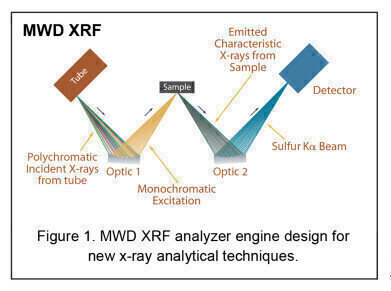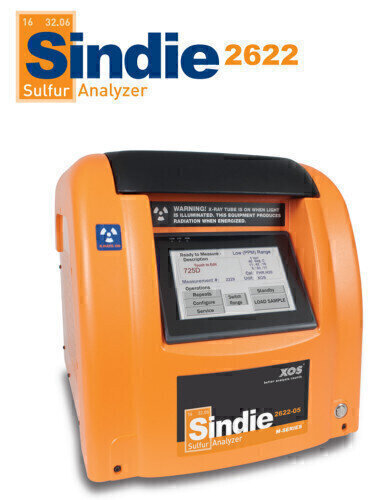-

-
 Figure 2: the Sindie Sulfur Analyzer
Figure 2: the Sindie Sulfur Analyzer
Analytical Instrumentation
Preparing for Upcoming Tier 3 Requirements
Oct 28 2014
The U.S. Environmental Protection Agency (EPA) recently enacted new, lower sulphur level requirements in gasoline through the Tier 3 rule, part of a comprehensive approach to reducing the impacts of motor vehicles on air quality and public health. The Tier 3 regulations are expected to be implemented in 2017, and call for reduced sulphur levels in the range of 10 ppm. There is still debate regarding the cost and the scope of the implementation, but most would agree that refiners will need to make adjustments to their process infrastructure in order to meet this new specification.
In order to make the transition as smooth as possible, it is critical to seek out the most efficient and precise technologies for measuring sulphur at these new ultra-low levels. XOS (USA) has been at the forefront of elemental analysis of petroleum products for well over a decade, supplying tools like the Sindie Sulfur Analyzer to aid with the ultra-low-sulphur-diesel (ULSD) implementation in the early 2000s as well as the California Air Resources Board (CARB) requirements for gasoline.
Although x-ray fluorescence (XRF) technology has been a standard in the petroleum business for many years, the introduction of XOS-patented monochromatic wavelength dispersive x-ray fluorescence (MWD XRF) technology has surpassed the traditional limits of XRF sulphur analysis. MWD XRF, a simplified and highly robust x-ray technique, provides sub-1 ppm sulphur detection.
An MWD XRF analyser engine (Figure 1) consists of a low-power x-ray tube, a point-to-point focusing optic for excitation, a sample cell, a second focusing optic for collection and an x-ray detector. The first focusing optic captures a narrow bandwidth of x-rays from the source and focuses this intense monochromatic beam to a small spot on the fuel cell. The monochromatic primary beam excites the sample and secondary characteristic fluorescence x-rays are emitted. The second collection optic collects only the characteristic sulphur x-rays that are then focused onto the detector.
In addition to sub-1 ppm sulphur detection, monochromatic excitation provides another important advantage over polychromatic excitation: simplified quantification and matrix effect correction. By using a single wavelength for the primary beam, the fluorescence intensity of an element in a sample can be related to its concentration by simple equations relying on the fundamental parameters of materials at only two wavelengths. This eliminates the need for sophisticated correction methods and increases the accuracy and reliability of the measurement results—key factors when deciding which ASTM method to follow for sulphur analysis.
The XOS Sindie 2622 Sulfur Analyzer offers compliance with both ASTM D2622 and ASTM D7039. The ASTM D2622 method is one of the original sulphur analysis methods via XRF. It references a large range of products ranging from gasoline and jet fuel to crude oil. Per the EPA, D2622 is currently the designated test method for measuring sulphur in gasoline and, moving forward, it will be the designated method named by the EPA for the Tier 3 rule. Sulphur test method ASTM D7039 is based on MWD XRF technology. With acceptance in product specifications such as D4814 for gasoline and D975 for diesel, the D7039 method provides a great option for running sulphur in fuels. The D7039 method has been listed as alternative test in the Tier 3 ruling. Of course, the United States isn’t the only country where low level sulphur regulations are in place for gasoline. The Sindie Analyzer also conforms to ISO 20884, which is the accepted WDXRF method in Europe and other regions of the world. In Europe, XOS Sindie Analyzers are used to meet Euro V applications, while in China XOS Sindie Analyzers are used for similar China V specification testing.
WDXRF is a long-standing proven technology, and the enhancements achieved through MWD XRF allow for the additional speed and precision necessary to meet increasingly stringent sulphur regulations, such as Tier 3.
Digital Edition
PIN 25.2 Apr/May
April 2024
In this Edition Safety - Carbon monoxide toxic and flammable gas detection Analytical Instrumentation - Density: A fundamental parameter at critical stages within the petroleum sector...
View all digital editions
Events
May 03 2024 Seoul, South Korea
May 05 2024 Seville, Spain
May 06 2024 Riyadh, Saudi Arabia
May 06 2024 Houston, Tx, USA
May 06 2024 Houston, Tx, USA

















